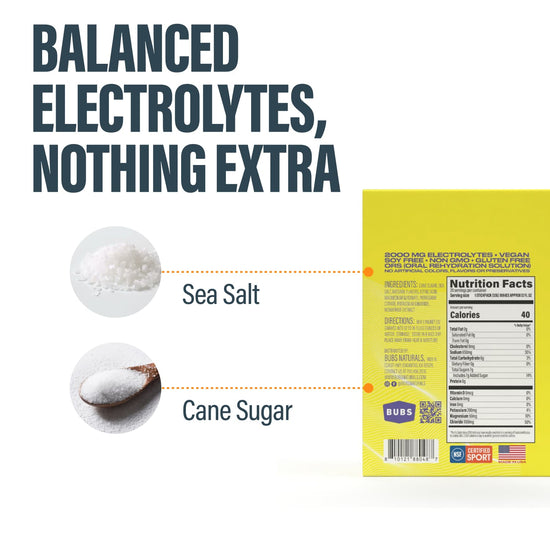Table of Contents
- Introduction
- Understanding Electrolytes: What Are They and Why Do We Need Them?
- Foods Rich in Electrolytes
- Recognizing Electrolyte Imbalance
- How to Incorporate Electrolyte-Rich Foods into Your Diet
- Conclusion
Introduction
Did you know that your body is composed of about 60% water, and maintaining the balance of fluids within that water is crucial for optimal health? Electrolytes play a pivotal role in this balance, acting as minerals that carry an electric charge essential for various bodily functions. These functions include regulating nerve and muscle function, maintaining hydration, and balancing pH levels. Yet, many of us are unaware of the foods that can help replenish these vital minerals, especially when we are active or experiencing heat stress.
At BUBS Naturals, we are committed to adventure, wellness, and giving back, drawing inspiration from Glen "BUB" Doherty's legacy. Just as BUB’s adventurous spirit taught us about resilience and nourishment, understanding the importance of electrolytes can empower us to make informed choices about our health and wellness. In this post, we'll explore the foods that can help you maintain electrolyte balance, how to recognize when your body needs these minerals, and the best ways to incorporate them into your daily diet.
By the end of this article, you will have a clear understanding of which foods are rich in electrolytes, how they contribute to your overall wellness, and why it's essential to prioritize them in your diet. We will cover key electrolytes such as sodium, potassium, calcium, magnesium, and phosphorus, as well as provide practical tips on how to include these foods in your meals. So, let's dive into the world of electrolytes and discover how simple dietary choices can support your active lifestyle.
Understanding Electrolytes: What Are They and Why Do We Need Them?
Electrolytes are minerals found in your body fluids that carry an electric charge. They are crucial for various bodily functions, including:
- Regulating Fluid Balance: Electrolytes help control the amount of water in your body, ensuring cells are hydrated.
- Supporting Muscle Function: Minerals like calcium and potassium are essential for muscle contractions, including the heart muscle.
- Facilitating Nerve Transmission: Electrolytes enable the transmission of electrical signals in the nervous system, allowing communication between your brain and body.
- Maintaining Acid-Base Balance: They help regulate the pH levels in your body, which is vital for metabolic processes.
The primary electrolytes include:
- Sodium: Critical for fluid balance and nerve function.
- Potassium: Essential for heart health and muscle function.
- Calcium: Important for bone health and muscle contractions.
- Magnesium: Supports muscle and nerve function and regulates blood pressure.
- Phosphorus: Involved in energy production and bone health.
Foods Rich in Electrolytes
1. Fruits
- Bananas: Often celebrated for their potassium content, a medium banana contains about 422 mg of potassium, making it a convenient snack for replenishing electrolytes.
- Avocados: Not only a source of healthy fats, but half an avocado also contains around 487 mg of potassium, along with magnesium and fiber.
- Oranges: A single medium orange provides approximately 237 mg of potassium and is a refreshing way to hydrate.
- Watermelon: This hydrating fruit offers potassium, magnesium, and a delicious way to cool down on hot days.
- Dried Apricots: A concentrated source of potassium, a cup of dried apricots delivers an impressive 1,030 mg of potassium.
2. Vegetables
- Spinach: A nutrient powerhouse, one cup of cooked spinach contains about 839 mg of potassium, as well as calcium and magnesium.
- Sweet Potatoes: These starchy veggies are packed with about 542 mg of potassium per medium-sized potato and are versatile for many dishes.
- Potatoes: A medium baked potato with skin can deliver around 926 mg of potassium, providing a satisfying and nutritious option.
- Beets: Rich in potassium and antioxidants, beets can help maintain healthy blood pressure levels.
3. Dairy and Dairy Alternatives
- Milk: Both cow's milk and fortified plant-based milks are excellent sources of calcium, potassium, and magnesium. A cup of cow's milk contains about 300 mg of calcium and 400 mg of potassium.
- Yogurt: A great post-workout snack, yogurt contains calcium, potassium, and probiotics for gut health. Choose plain varieties to avoid excess sugar.
- Cottage Cheese: This creamy delight offers around 97 mg of potassium and is packed with protein, making it a perfect addition to meals.
4. Nuts and Seeds
- Almonds: An ounce of almonds contains about 200 mg of potassium and provides healthy fats and protein.
- Pumpkin Seeds: These seeds are rich in magnesium and phosphorus, delivering about 150 mg of magnesium per ounce.
- Chia Seeds: Packed with fiber and healthy fats, chia seeds also provide potassium and magnesium, making them a great addition to smoothies and oatmeal.
5. Legumes
- Beans and Lentils: These are fantastic sources of potassium and magnesium. For example, a half-cup of cooked lentils contains about 366 mg of potassium and significant amounts of fiber.
- Tofu: A versatile protein source, especially for vegetarians, tofu can be rich in calcium and magnesium depending on the coagulant used in its production.
6. Seafood
- Salmon: This fatty fish is not only rich in omega-3 fatty acids but also provides about 416 mg of potassium per 3-ounce serving.
- Sardines: Packed with electrolytes, a can of sardines provides calcium, potassium, and is an excellent protein source.
7. Other Foods
- Coconut Water: Often dubbed "nature's sports drink," coconut water is naturally rich in potassium and contains sodium and magnesium as well.
- Pickles: While high in sodium, pickles can help replenish lost electrolytes after sweating. A single dill pickle can contain around 326 mg of sodium.
- Bone Broth: This nutritious liquid offers a variety of electrolytes, including sodium and magnesium, and is great for hydration.
Recognizing Electrolyte Imbalance
Electrolyte imbalance can occur due to various factors, including excessive sweating, dehydration, illness, or certain medications. Symptoms may include:
- Muscle cramps
- Fatigue
- Nausea or vomiting
- Confusion
- Irregular heartbeat
If you experience any of these symptoms, it's essential to consult a healthcare professional for appropriate evaluation and treatment.
How to Incorporate Electrolyte-Rich Foods into Your Diet
Now that you know which foods are rich in electrolytes, here are some practical tips for incorporating them into your daily meals:
- Start Your Day Right: Include yogurt with fruits like bananas or strawberries for breakfast. Add a sprinkle of chia seeds for an extra boost.
- Snack Smart: Keep nuts or dried fruits handy for quick snacks throughout the day. They are portable and nutrient-dense.
- Hydrate Wisely: Instead of reaching for sugary sports drinks, consider coconut water, or make your own electrolyte drink by mixing water with a pinch of salt and a splash of orange juice.
- Include Variety: Aim to include a variety of colorful fruits and vegetables in your meals to ensure you are getting a wide range of electrolytes.
- Experiment with Recipes: Try new recipes that highlight electrolyte-rich foods, such as spinach salads, sweet potato casseroles, or bean-based soups.
- Post-Workout Recovery: After exercising, enjoy a smoothie with spinach, banana, and a scoop of protein powder. Alternatively, a bowl of cottage cheese with fruits makes for a great recovery meal.
Conclusion
Incorporating foods that help with electrolytes into our diets is a simple yet effective way to support our overall health and wellness. By understanding the role of electrolytes and recognizing which foods provide them, we can make informed choices that align with our active lifestyles.
At BUBS Naturals, we are passionate about promoting wellness through clean, functional nutrition that fuels adventure and supports our community. Remember, a balanced diet rich in fruits, vegetables, nuts, seeds, and whole grains can help maintain your electrolyte levels without the need for excessive supplementation.
As we reflect on Glen "BUB" Doherty's legacy of resilience and purpose, let’s commit to nourishing our bodies with the right foods to ensure we’re ready for whatever adventures lie ahead.
FAQ
1. How much sodium do I need daily?
The general recommendation for sodium intake is less than 2,300 mg per day for most adults. However, individual needs may vary based on activity level and health conditions.
2. Can I get electrolytes from water?
While plain water does contain some electrolytes, it typically does not provide enough to meet your daily needs. Consuming a balanced diet rich in electrolyte-containing foods is essential.
3. What are the symptoms of an electrolyte imbalance?
Symptoms can include muscle cramps, fatigue, nausea, confusion, and irregular heartbeat. If you notice any of these signs, it’s important to consult with a healthcare professional.
4. Are sports drinks necessary for replenishing electrolytes?
For most people, especially those who are not engaging in prolonged or intense physical activity, whole foods and water are sufficient. Sports drinks may be beneficial for athletes during extreme exertion.
5. Can I take electrolyte supplements?
While supplements can be helpful in certain situations, it's best to prioritize obtaining electrolytes from whole foods. Always consult with a healthcare professional before starting any supplements.
With this knowledge about how to replenish and maintain your body's electrolytes, you’re now equipped to make healthful choices that support your active lifestyle. Together, let’s embrace wellness, adventure, and community!
Written by:
Bubs Naturals

Hydrate or Die
When you’re sweating hard—whether it’s from a tough workout, a long day in the sun, or just life—your body needs more than water to stay balanced and energized.
Hydrate or Die® delivers 2,000 mg of electrolytes in every serving to help you rehydrate faster, fight off fatigue, and keep going strong. That includes the right mix of sodium, potassium, and magnesium to support muscle function, prevent cramps, and maintain energy levels.
With a small dose of natural cane sugar to speed up absorption, this clean, easy-to-use powder is made for real performance—not just flavor.
Starts at $29.60
Shop

